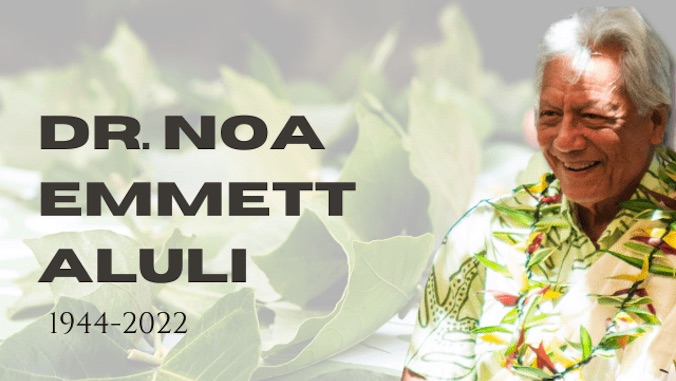
“He pioneered a distinctively Native Hawaiian approach to health care in rural Hawaiian communities that he modeled for medical students who shadowed him. He believed that each patient’s health and well-being needed to be understood in the context of their ʻohana, their genealogy, their lifestyle, and their ʻāina. He shared the philosophy that ‘The health of the land is the health of the people, is the health of the nation.’ He leaves a big gap in health care for the island of Molokaʻi that can hopefully be filled from among those he mentored.” —The Aluli ʻOhana
It’s not an exaggeration to say that Noa Emmett Aluli shaped the Hawaiʻi we live in today. Before delving into his dedication to rural health, Aluli may be remembered most for helping to get the U.S. Navy to cease bombing Kahoʻolawe.
Aluli, one of five Native Hawaiians who were part of the first class of graduates from the four-year pilot program at the University of Hawaiʻi at Mānoa medical school (not yet named for John A. Burns.), died on November 30.
1975 was a pivotal year for Aluli. After graduating from the UH medical school, he worked with the ALOHA Organization (Aboriginal Lands of Hawaiian Ancestry), and decided to occupy Kahoʻolawe in December of that year.
According to Aluli’s life partner Davianna McGregor, in a Hawaiʻi Public Radio interview she and Aluli did in 2022, after an ALOHA-sponsored bill to recognize Native Hawaiians’ rights failed to get traction, the decision to occupy federal land was a last-ditch effort to draw national attention to the conditions of Native Hawaiians.
Occupying Kahoʻolawe
On January 3, 1976, about 100 people across Hawaiʻi planned to descend on Kahoʻolawe. As McGregor told HPR, someone leaked the information, and the Coast Guard was called. Most of the people and boats that gathered started to disperse, but only one boat, carrying nine people, made it to the shore of Kahoʻolawe. These would be known as the “Kahoʻolawe Nine.” Aluli was one of them. He and another man, Walter Ritte, were the only ones who stayed for two days to survey the island.
During his two days of surveying the damage, Aluli told HPR that bomb craters and unexploded devices were everywhere while tens of thousands of goats kept any vegetation from growing.
“So that just started the movement, ‘Hey, we gotta stop the bombing.’ We were there for Aloha ʻĀina. Aloha ʻĀina was the reason for the ending of the bombing,” Aluli said.
In addition to court action, it would take a series of occupations on Kahoʻolawe for the U.S. to cease bombing in 1990. In 2003, the island was transferred to the state of Hawaiʻi. Aluli played a pivotal role in getting the Navy to stop the bombing. He also played a key role in rehabilitating Kahoʻolawe from the damage left behind by the military explosives.
“The continued restoration, healing, and mālama of Kahoʻolawe today is owed to Dr. Aluli,” said Keaweʻaimoku Kaholokula, chair of the Department of Native Hawaiian Health at the John A. Burns School of Medicine (JABSOM). “It is one of if not the most significant and successful acts of reclamation in our history after the unlawful overthrow of Queen Liliʻuokalani. I cannot overstate the importance of this event on the psyche and mauli ola (breath of life) of our Lāhui (people). It empowered his generation and all generations of Hawaiians since to stand up against unjust acts and desecration of our natural and cultural resources.”
A trailblazer for rural health
Aluli was a true defender of Hawaiʻi, and throughout his life, he’d continue to fight for Hawaiians by calling on his medical background from JABSOM.
This is the legacy of Dr. Aluli. He koa, he kauka, he kanaka—a warrior, a healer and a servant to our community.
—Keaweʻaimoku Kaholokula
True to JABSOM’s current mission, Aluli was determined to serve all of Hawaiʻi, including the most rural areas. He was always a trailblazer, completing his residency on Molokaʻi and later creating the Molokaʻi Family Health Center and Clinic. There would be times when he’d be the only physician on the island.
He was co-founder of Nā Puʻuwai, the Native Hawaiian Health Care System that serves the islands of Molokaʻi and Lānaʻi. To this day, both facilities serve a large population of Native Hawaiians.
For several years, Aluli served as medical director of Molokaʻi General Hospital. Much of his research took place on Molokaʻi, including the first Native Hawaiian heart study, Nā Puʻuwai, that engaged more than 300 Molokaʻi Hawaiian homesteaders to learn more about heart health. More recently, he was a co-principal investigator of Hua Kanawao Ka Liko — A Generational Study of Heart Health among the Hawaiians on Molokaʻi, a community based participatory research initiative.
Aluli remained politically active, serving as a member of the 2nd Congressional District’s Native Hawaiian Health Task Force. He helped draft the Native Hawaiian Health Care Improvement Act that was signed into law in 1988 to promote health and disease prevention services to improve the health status of Native Hawaiians.
His actions helped to set federal legislative priorities and policies to advance Native Hawaiian healthcare.
“This is the legacy of Dr. Aluli,” Kaholokula said. “He koa, he kauka, he kanaka—a warrior, a healer and a servant to our community.”
For more, go to the JABSOM website.

